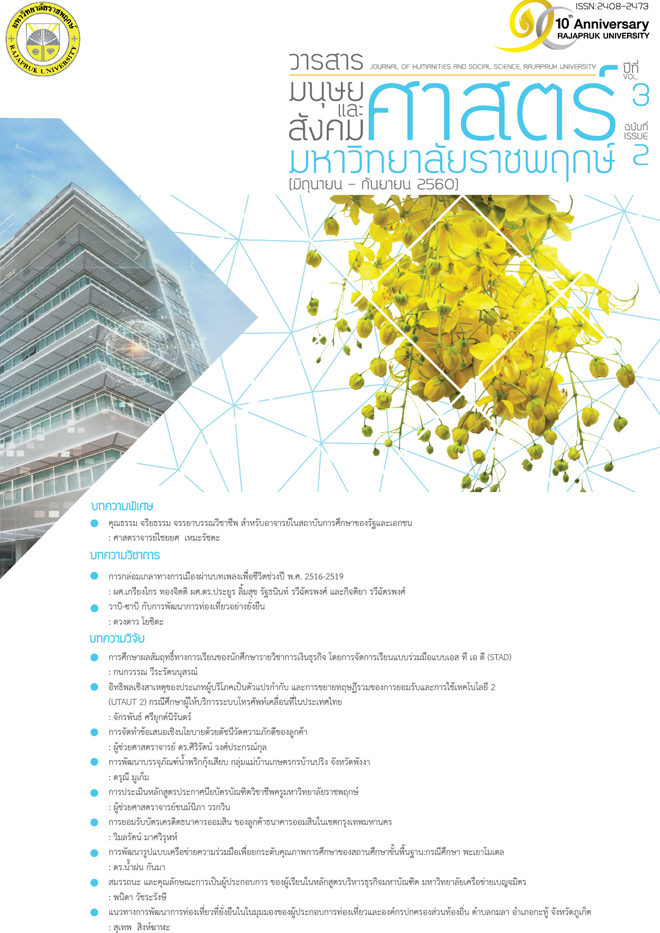Influence of Moderating Effect Consumer Type and Extended Unified Theory of Acceptance and Use of Technology 2 (UTAUT2): Case Study Thai Mobile Service Providers
Main Article Content
Abstract
This research studied on consumers’ behavioral acceptance and use of technologies by combining Unified Theory of Acceptance and Use of Technology 2 (UTAUT2). Such theories extend this study by emphasizing the moderating factor of “Consumer Type”, which is a psychological factor or internal factor of the consumers. The psychological factor is anticipated to improve a better sense in consumers’ behavior altogether with reducing limitation to implement in practice; and effectively enabling to explain consumers’ behavioral intention and use of technologies. Furthermore, none of the past studies were conducted by this factor to study its impact in the sides of consumers’ behavioral uses of products or services.
This research is purposed to attain performance expectancy, effort expectancy, social influence, facilitating conditions, hedonic motivation, price vale, habit, perceived security and behavioral intention that are currently influencing service providers’ behaviors to use mobile services systems. Moderated variables are (1) Gender (2) Age (3) Experiences (4) Consumer type. The researcher has conducted factors analysis to search for all elements of variables that are appropriated and also conducted structure equation modeling to observe all variables structures to examine all assumptions. By profoundly addressing Thai population in all regions as targets, the researcher used particular questionnaire in connection with analysis results to facilitate the assumptions. The researcher found that performance expectancy, effort expectancy, social influence, facilitating conditions, hedonic motivation, price vale, habit, perceived security have indirect consequences toward the behavioral use through behavioral intention. But they have direct influences toward behavioral intention that benefit the development of marketing strategies. They create competency in competition and preserve the consumer base who have pre-existing relationships or expand the business for sustainability. Moreover, the correlated businesses or technology businesses can adapt their model by using this as a guideline to impose their marketing strategies.
Article Details
References
Assael, H. (1992). Consumer Behaviour & Marketing Action, 4th. Ed., PWS Kent, Boston,MA.
Babin, B. J., Darden, W. R., Griffin, M. (1994). Work and/or Fun: Measuring Hedonic and Utilitarian Shopping Values. Journal of Consumer Research, 20(3), 644-656.
Bellman, S., Lohse, G. L., & Johnson, E. J. (1999). Predictorss of online buying behavior. Communications of the ACM, 42(2), 32-38.
Bhatti, H., Abareshi, A., & Pittayachawan, S. (2016). An empirical examination of customer retention in mobile telecommunication services in Australia. in International Joint Conference on e-Business and Telecommunications, Lisbon, Portugal, 6(1), 72-77.
Brancheau, J. C., Janz, B. D., & Wetherbe, J. C. (1996). Key issues in information systems management: 1994-95 SIM Delphi Results. MIS Quarterly, 20 (2), 225-242.
Escobar-Rodríguez, T., & Carvajal-Trujillo, E. (2013). Online drivers of consumer purchase of website airline tickets. Journal of Air Transport Management 32. 58-64. doi:10.1016/j.jairtraman.2013.06.018
Fuksa M. (2013). Mobile technologies and services development impact on mobile Internet usage in Latvia. Procedia Computer Science, 26, 41–50.
Hartono, E., Holsapple, C., Kim, K., Na, K. & Simpson, J. (2014). Measuring Perceived Security in B2C Electronic Commerce Website Usage: A Respecification and Validation. Decision Support Systems, 62, 11-21.
Hevner, A. R., March, S. T. , Park, J., & Ram, S. (2004). Design science in information system Research. MIS Quarterly, 28(1), 75-105.
Hirschman, E. C. (1980b). Innovativeness, Novelty Seeking and Consumer Creativity. Journal of Consumer Research, 7 (12), 283-295.
Khemthong, S. (2007). Adoption and Diffusion of Internet and Web Technologies in Hotel Marketing: A Study of Hotels in Thailand and Australia. Ph.D. dissertation, Faculty of Business and Law, Victoria University.
Kuo, Y.-F., & Yen, S.-N. (2009). Towards an understanding of the behavioral intention to use 3G mobile value-added services. Computers in Human Behavior, 25(1), 103-110.
Mafé, C.R., Blas, S.S., & Tavera-Mesías, J.F. (2010). A comparative study of mobile messaging services acceptance to participate in television programmes. Journal of Service Management, 21(1), 69-102.
Rogers, E.M., & Shoemaker, F.F. (1971), The Communication of Innovations. New York: Free Press.
Roscoe, J.T. (1975). Fundamental research statistics for the behavioral sciences. New York: Holt, Rinehart, & Winston.
Venkatesh, V., Morris, M. G., Davis, G. B., & Davis, F. D. (2003). User acceptance of information technology: Toward a unified view. MIS Quarterly, 27(3), 425-478.
Venkatesh, V., Thong, J. Y. L., & Xu, X. (2012) Consumer acceptance and use of information technology: Extending the Unified Theory of Acceptance and use of technology. MIS Quarterly, 36(1), 157-178.
Wu, S.I., & Chang, H.J. (2011). Perceived service quality and self-concept influences on consumer attitude and purchase process: A comparison between physical and internet channels. Journal Total Quality Management & Business Excellence, 22(1), 43-62.
Xu, S., Zhu, K., & Gibbs, J. (2004). Global technology, local adoption: across-country investigation of Internet adoption by companies in the United States and China. Electronic Markets, 14(1), 13–24.


